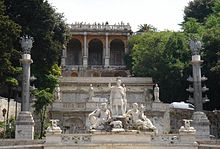Pincio

The Pincio (also Monte Pincio ; Latin Mons Pincius ) is a hill in the northern urban area of Rome . It is not one of the Seven Hills of Rome and belonged to the 7th Augustan region .
The hill was originally outside the ancient city. Large villas and gardens were laid out there in the late Republic . The Horti Luculliani created by Lucius Licinius Lucullus , in which Messalina , Claudius's wife , was killed, later passed into imperial property, as did the Horti Pompeiani to the north-west of it and the Horti Sallustiani of the historian Sallust directly south of the Pincio. The hill was named collis hortulorum ("garden hill ") because of these complexes, to which the Horti Aciliorum of the Acilii Glabriones belonged, was included in the urban area during the imperial era (when Claudius expanded the Pomerium ) and was densely built. The tomb of Domitii , in which Nero's ashes were buried, stood on the hill . The Porta Pinciana of the Aurelian city wall is named after the Pincio .
The current name of the hill possibly goes back to the Pincii family who owned a large estate there in late antiquity (domus Pinciana) , which later became imperial property.
To the east of the Piazza del Popolo , stairs lead to the Pincio Park. The path is lined with a small artificial waterfall. A little further south, the Spanish Steps by the architect Francesco De Sanctis lead to the Pincio Hill. The Villa Borghese park is directly adjacent .
On the Viale dell'Obelisco is the Antinous Obelisk with a height of 9.25 meters.
literature
- Filippo Coarelli : Rome. An archaeological guide. Verlag von Zabern, Mainz 2000, ISBN 3-8053-2685-8 , pp. 254-258.
- Samuel Ball Platner , Thomas Ashby : Pincius Mons , Horti Luculliani and Horti Aciliorum . In: A Topographical Dictionary of Ancient Rome . Oxford University Press, London 1929, pp. 391, 268-269, 364.
Web links
Remarks
- ↑ Tacitus , Annales 11, 1 ; 32 ; 37 .
- ^ Suetonius , Nero 50 .
- ↑ Senator Pincius mentioned in Cassiodor , Variae 3, 10. On the domus Pinciana : Vincent Jolivet, Claire Sotinel: The Domus Pinciana. An imperial residence in Rome. In: Therese Fuhrer (ed.): Rome and Milan in late antiquity. Representations of urban spaces in literature, architecture and art. De Gruyter, Berlin 2011, pp. 137-160 ( online ).
Coordinates: 41 ° 55 ' N , 12 ° 29' E

